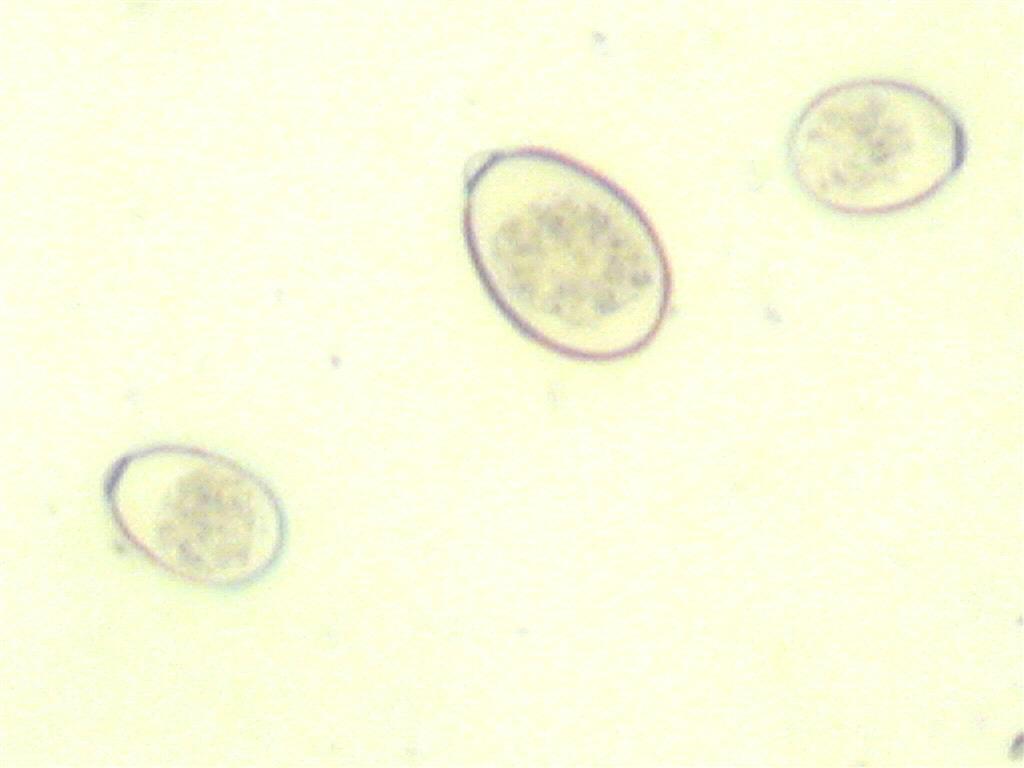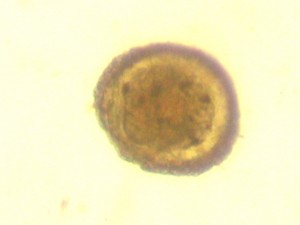
The following information is a simple summary of some of the more common intestinal parasites that can affect your horse’s health. There are hundreds of in-depth articles and even textbooks available if you’d like to learn more information on this topic.
Strongyles
This is the most common type of egg found in the fecal sample. There are two main types, “large” and “small”. All Strongyles start out as eggs scattered throughout the environment (feces, soil, etc.) which hatch into larvae that are consumed by horses as they graze or drink infected water. The larvae mature in the intestinal tract. The “large” Strongyles migrate into either the blood vessels of the intestines or migrate into the liver. “Small” Strongyles stay within the intestines and burrow (encyst) within the wall of the large intestine. Here they can stay for months or years before the proper conditions trigger them to emerge. While Strongyles are in this stage, they are not shedding eggs and are not impacted by dewormers but are doing the most damage to the horse. The “large” Strongyles can cause severe or even fatal colic or blood vessel ruptures as well as weight loss, anemia or colic and the encysted “small” Strongyles can severely damage the walls of the intestines.
Sooner or later, all Strongyles migrate back to the intestines and adhere to the inner walls. This is when the worms are the least damaging to the horse. This is when the worms shed their eggs which we find in their feces.
Roundworms
These worms (also called ascarids) have an interesting life cycle: The eggs lay dormant in contaminated hay or water and are eventually swallowed by the horse. These eggs soon develop into larvae within the horse’s stomach and then migrate to the liver, heart and lungs, where they are coughed up and swallowed. Once back in the stomach, they develop into egg-laying adults. These eggs bare also easly identified in fecal samples. As with the Strongyles, the most damage occurs as roundworms migrate through the body, causing coughing, pneumonia, liver damage, diarrhea and colic. Small numbers of Roundworms can live within the horse’s digestive system asymptomatically.
Tapeworms
Equine tapeworms (cestodes) require an intermediate host to mature. Tapeworm eggs are ingested by the “orabatid” mite that lives on the blades of grass in pastures. Horses ingest the mites (and the tapeworm eggs inside the mites) while they graze. Inside the horse, the tapeworm eggs mature into adult tapeworms that attach to the intestinal lining. Packets of eggs break off from the tapeworm and are passed out in the horse’s feces, where they are ingested by pasture mites and the cycle starts again. Unfortunately, because of the sporadic way in which tapeworms release their eggs, the routine fecal test is not a reliable means of determining whether a horse is infected. Tapeworms release little packets of eggs at intermittent times, so there is a only a small chance of finding them in a fecal sample. Tapeworm eggs (with its familiar “D” shape) are occasionally found during the routine fecal exam.
Coccidia
Coccidia are easily identified in the fecal specimen. Coccidia usually infect young horses.
Pinworms
The entire life cycle, from egg to adult, takes place in the gastrointestinal tract of a single horse. The life cycle begins with eggs being ingested. The eggs hatch in the first part of the small intestine). The pinworm larvae grow and migrate through the small intestine towards the colon. During this migration they become adult females and males. The male and female pinworms mate in the intestines. Soon after, the male pinworms usually die and are passed out with stool. The female pinworms settle in the large intestines where they attach themselves to the inner walls and ingest colonic contents. Soon, the female pinworms migrate towards the rectum and emerge from the anus. It is thought they do this to obtain the oxygen necessary for the maturation of the eggs. While moving on the skin near the anus, the female pinworm deposits its eggs and dies. The eggs in the skin around the horse’s anus are often rubbed off onto the ground where they are then eaten by a horse and the life cycle repeats. Because of this bizarre life-cycle, pinworm eggs are not often seen within the routine fecal sample.
Bots
Another interesting life cycle. Adult bot flies deposit their eggs on horses’ forelegs and shoulders, or around the horse’s jaws and lips. When the larvae hatch, they move into the mouth where they burrow into the tissues of the gums and the tongue to develop further. Eventually, they migrate into the stomach and intestines where they live for up to 12 months before passing out of the horse and develop into adult bot flies in the soil. These parasites are not seen during routine fecal analysis.





